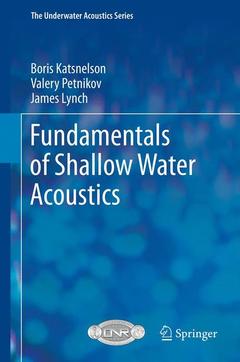Fundamentals of Shallow Water Acoustics, 2012 The Underwater Acoustics Series
Auteurs : Katsnelson Boris, Petnikov Valery, Lynch James

Dr. James F. Lynch was born in Jersey City, New Jersey on June 3, 1950. He obtained his B.S. in Physics from Stevens Institute of Technology in 1972 and his Ph.D. in Physics from the University of Texas at Austin in 1978. He then worked for three years at the Applied Research Laboratories of the University of Texas at Austin (ARL/UT) from 1978 to 1981, after which he joined the scientific staff at the Woods Hole Oceanographic Institution (WHOI). He has worked at WHOI since then, and currently holds the position of Senior Scientist in the Applied Ocean Physics and Engineering Department. His research specialty areas are ocean acoustics and acoustical oceanography. He also greatly enjoys occasional forays into physical oceanography, marine geology, and marine biology. Dr. Lynch is a Fellow of the Acoustical Society of America, a Fellow of IEEE, the former Editor-in-Chief of the IEEE Journal of Oceanic Engineering, and present Editor of JASA-EL. He recently received the 2009 Walter Munk Award in Oceanography from the Oceanography Society and the Secretary of the Navy. His hobbies include kempo karate and amateur astronomy and meteorology.
B.Katsnelson was born in Kursk, Russia on April 2, 1950. He obtained his B.S. in Physics from Voronezh State University in 1972 and his Ph.D. in Theoretical Physics from Voronezh University in 1976. He then worked in the Physics Dept of Voronezh University as a Senior Scientist and then as Professor up to now. His research areas at different times were the theory of the interaction of laser fields with atoms and molecules, the propagation of electromagnetic waves in plasma and currently sound propagation in the ocean. He is a Fellow of the Acoustical Society of America and member of the Russian Acoustical Society. His hobbies are tennis and classical music.
Prof. Valery G. Petnikov was born in Moscow, Russia on December 20, 1947. He obtained his B.S. /M.S. in Physics and his Ph.D in Physics and Mathematics from M.V. Lo
Ouvrage de 540 p.
15.5x23.5 cm
Ouvrage de 540 p.
15.5x23.5 cm



